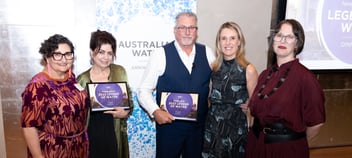Questacon wastewater display gets Canberran hands dirty — virtually

A virtual reality (VR) installation hosted by Icon Water at its Q Lab display helped engage the public with the importance of keeping sewage networks and waterways healthy and free of foreign objects.
Building water and wastewater literacy throughout the Canberra community is a key goal for Icon Water, said Davina McCormick, General Manager Customer Engagement.
“Wastewater is inherently out of sight, out of mind; however, flushing a problem doesn’t make it go away,” she said.
“National Water Week provided an opportunity to get the community to think about where their water comes from, where it goes and what we can all do to keep Canberra’s water and wastewater flowing smoothly.”
To develop community understanding of these issues, Icon Water relaunched a tablet game based on its “Free the Poo” campaign and paired it with a VR experience that immersed Questacon visitors in the wastewater treatment process.
“The VR experience builds upon our Blockage Buster Series, where the grosser the content the more engagement we get,” McCormick said.
“To develop the experience, we worked closely with the amazing staff at our Lower Molonglo Water Quality Control Centre to make this experience a reality. With their help we lowered a 360-degree camera into our sludge holding tank to capture the cleaning process from start to finish.
“The sludge holding tank is the receptacle for all solid waste recovered during the wastewater treatment process. Rubbish, such as wet wipes, seriously disrupts the tank’s operations, hindering the facility’s treatment of Canberra’s waste. The seven-minute experience gives the participants the perspective of what it is like to be in the tank alongside our Blockage Busters.”
Dirty work
For Icon Water’s workers, clearing out tank blockages is physically demanding work that leaves them utterly exhausted and covered in filth.
“The VR experience depicts each stage of the cleaning process – climbing inside, pulling apart the blockages, hosing the tank, climbing out and getting hosed down. We also have voice-overs from some of the team in the tank and an interview with one of them at the end,” McCormick said.
“We created this experience to shed some light on Canberra's unsung heroes doing the dirty work to prevent blockages and protect our critical wastewater assets. We really want to show people that flushing a problem doesn't make it go away; there's always someone on the other end dealing with it.”
Efforts like this help to focus community attention on the work that goes into delivering essential water and wastewater services.
“It’s hard to value what you don’t see. In our most recent customer engagement activities that involved over 17,500 participants, Canberrans told us they want us to be more visible and share these messages,” McCormick said.
“They want to do their part in ensuring service quality, water security and reliability, protecting our environment and ultimately increasing the liveability of our city.”
Icon Water’s partnership with Questacon during National Water Week involved other demonstrations designed to engage – and, in some cases, disgust – the community.
“The VR experience was loved by all – even the few that were gagging just from watching someone else in the experience,” McCormick said.
“As part of our partnership with Questacon they also ran some water-focused experiments including a bottle accelerometer, which mimicked the Acton Siphon While these are all-ages, fun experiments, it was also an opportunity for people to get an idea of how a critical piece of their city’s water network functions.”
Appreciating wastewater
Sewer network health is an important issue that the Icon Water wants to highlight on an ongoing basis, McCormick said.
“Wastewater health is not just important through National Water Week; it’s important all the time,” she said.
“Wastewater is often the unseen half of the urban water cycle. Most people understand that water moves from our dams to their taps. However, our research has shown us few think about wastewater moving from their drains and ultimately back to the river after treatment.
“National Water Week isn’t just about appreciating the water we drink; it’s about learning what efforts go into delivering the services that are so essential to our quality of life.”


